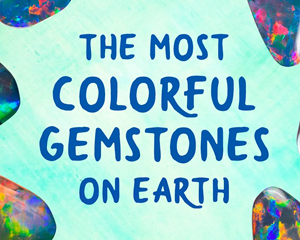On an auspicious day in November of 1986, 5 Australian miners climbed Lunatic Hill -- so named for the mental state anyone would be in to dig there.
1986年11月的一个吉日,五个澳大利亚矿工爬上“疯人山”--一个只有“疯子”才会去采矿的地方。
While their competitors searched for opals at a depth of 2 to 5 meters, the Lunatic Hill Syndicate bored 20 meters into the earth.
他们的对手在深约2-5米处寻找蛋白石,疯人山矿队在地下钻了20米。
And for their audacity, the earth rewarded them with a fist-sized, record breaking opal.
因为他们的大胆,地球奖励了他们一块拳头大小、超越纪录的蛋白石。
They named it the Halley's Comet opal, after the much larger rocky, icy body flying by the earth at that time.
他们把它命名为哈雷彗星蛋白石,这名字源于当时划过地球上空的哈雷彗星。
The Halley's Comet opal is a marvel, but its uniqueness is, paradoxically, the most usual thing about it.
哈雷彗星蛋白石是一个奇迹,但矛盾的是,它的独特性却是最寻常的。
While diamonds, rubies, emeralds, and other precious stones are often indistinguishably similar, no two opals look the same, thanks to a characteristic called "play of color."
钻石、红宝石、祖母绿和其他宝石,它们通常都十分相似,没有两种蛋白石看起来是一样的,多亏了一个叫做“色彩游戏”的特征。
This shimmering, dazzling, dancing display of light comes about from a confluence of chemistry, geology, and optics that define opals from their earliest moments, deep underground.
这闪烁、耀眼、舞动的光来自化学、地质学和光学的融合,从最早深埋于地下时就定义了蛋白石。
It's there that an opal begins its life as something surprisingly abundant: water.
在那里,蛋白石开始了它的生命,它起源于一种大量存在的物质:水。
Trickling down through gaps in soil and rock, water flows through sandstone, limestone, and basalt, picking up a microscopic compound called silicon dioxide.
从土壤和岩石的缝隙中滴下,水流过砂岩、石灰岩和玄武岩,并衔起一种叫二氧化硅的微观化合物。
This silica-enriched water enters the voids inside pieces of volcanic rock, prehistoric river beds, wood and even the bones of ancient creatures.
这种富含二氧化硅的水进入火山岩内部的空隙,史前河床、木材甚至是古代生物的骨骼。
Gradually, the water starts to evaporate, and the silica-solution begins forming a gel,
渐渐地,水开始蒸发,硅溶液开始形成凝胶,
within which millions of silica spheres form layer by layer as a series of concentric shells.
数百万个硅球层层形成,与同心壳一样。

The gel ultimately hardens into a glass-like material, and the spheres settle into a lattice structure.
凝胶最终硬化成玻璃状物质,球体则形成晶格结构。
The vast majority of the time, this structure is haphazard, resulting in common, or potch, opals with unremarkable exteriors.
绝大多数时候,这种结构是随意的,由此产生出普通的或杂乱,外观并不显著的蛋白石。
The tiny, mesmerizing percentage we call precious opals have regions where silica beads of uniform size form orderly arrays.
有一小部分形成迷人的蛋白石内部,是有硅胶珠形成的均匀大小的有序阵列组成的区域。
So why do those structures produce such vibrant displays? The answer lies in a principle of wave physics called interference.
那么,为什么这些结构会显得如此充满活力呢?答案在于一种叫做干涉的波动物理学原理。
For the sake of simplicity, let's look at what happens when a single color of light -- green, with a wavelength of 500 nanometers -- hits a precious opal.
为了简单起见,让我们看看当单一颜色的光--绿色,波长为500纳米--击中一块珍贵的蛋白石会怎么样。
The green light will scatter throughout the gemstone and reflect back with varying intensities
绿光会散射到整个宝石上并以不同的强度反射回来,
from most angles suffused, from some entirely dimmed, and others dazzlingly bright.
从大多数弥漫的角度,从一些完全暗淡的角度,其他的则令人眼花缭乱的明亮。
What's happening is, some of the green light reflects off of the top layer. Some reflects off of the layer below that. And so on.
这种现象的原因是,一些绿光从顶层反射出去。一些则从下面一层反射出去。等等。
When the additional distance it travels from one layer to the next, and back, is a multiple of the wavelength
当它从一层移动到下一层,然后再移动回来时,移动的距离是波长的倍数,
such as 500 or 1000 extra nanometers -- the crests and valleys of the waves match each other.
比如500或1000纳米,波浪的波峰和波谷相互匹配。
This phenomenon is called constructive interference, and it amplifies the wave, producing a brighter color.
这种现象叫做建设性干扰,它会放大波浪,产生更明亮的颜色。
So if you position your eye at the correct angle, the green light reflecting from many layers adds together.
所以如果你把眼睛放在正确的角度观察,从许多层反射的绿光则会叠加在一起。
Shift the angle just a bit, and you change the distance the light travels between layers.
稍微改变一下角度,你便可以改变光在每层之间传播的距离。
Change it enough, and you'll reach a point where the crests match the valleys, making the waves cancel each other out -- that's destructive interference.
如果改变的足够多,波峰和波谷便会出现重叠,使光波相互抵消--这是破坏性干扰。
Different colors have different wavelengths, which translates to varying distances they have to travel to constructively interfere.
不同的颜色有不同的波长,这就意味着它们必须经过不同的距离才能产生建设性的干扰。
That's why colors roughly correspond to silica bead sizes. The spaces between 210 nanometer beads are just right to amplify blue light.
这就是为什么产生的颜色会大致对应于二氧化硅珠的大小。210纳米珠子之间的间距正好可以放大蓝光。
For red light, with its long wavelengths, the silica beads must be close to 300 nanometers.
对于波长较长的红光,二氧化硅珠必须接近300纳米。
Those take a very long time to form, and because of that, red is the rarest opal color.
这需要很长时间才能形成,也正因为如此,红色是最稀有的蛋白石颜色。
The differences in the arrangements of the gel lattices within a particular stone result in a wide range of color patterns
凝胶晶格排列的差异在一块特殊的石头里会产生多种颜色图案,
everything from broad flash to pin-fire to the ultra-rare harlequin.
从最简单的闪光到针尖大小的花火,再到十分稀有的色彩斑斓。
The circumstances that lead to the formation of precious opal are so uncommon that they only occur in a handful of places.
导致珍贵蛋白石形成的环境非常罕见,它们只发生于极少数地方。
About 95% come from Australia, where an ancient inland sea created the perfect conditions.
这些稀有蛋白石大约95%来自澳大利亚,在那里,古老的内陆海创造了完美的条件。
It was there that the Halley's Comet opal formed some 100 million years ago.
大约一亿年前,哈雷彗星蛋白石就是在那里形成的。
Which raises the question: in the next 100 million years, silica-rich water will percolate through the nooks and crannies of some of the discarded artifacts of human civilization.
这就演发出了一个问题:在未来一亿年,富含二氧化硅的水将通过角落和裂缝,渗透进人类文明中一些被丢弃的人工制品。
What opalescent plays of light will one day radiate from the things we forget in the darkness?
有朝一日,这些被遗忘在黑暗中的历史会绽放出怎样的光芒呢?













